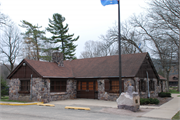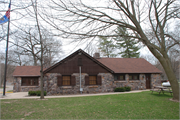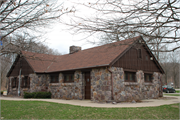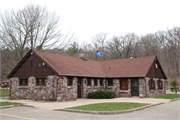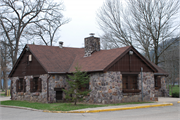Property Record
S5975 Park Road, DEVIL'S LAKE STATE PARK
Architecture and History Inventory
| Historic Name: | Devil's Lake State Park Administration Building |
|---|---|
| Other Name: | DNR: Devil's Lake # 1024 (DNR) |
| Contributing: | Yes |
| Reference Number: | 91111 |
| Location (Address): | S5975 Park Road, DEVIL'S LAKE STATE PARK |
|---|---|
| County: | Sauk |
| City: | |
| Township/Village: | Baraboo |
| Unincorporated Community: | |
| Town: | 11 |
| Range: | 6 |
| Direction: | E |
| Section: | 13 |
| Quarter Section: | NW |
| Quarter/Quarter Section: | SE |
| Year Built: | 1939 |
|---|---|
| Additions: | |
| Survey Date: | 19912013 |
| Historic Use: | small office building |
| Architectural Style: | Rustic Style |
| Structural System: | |
| Wall Material: | Cut Stone |
| Architect: | |
| Other Buildings On Site: | Y |
| Demolished?: | No |
| Demolished Date: |
| National/State Register Listing Name: | Devil's Lake State Park |
|---|---|
| National Register Listing Date: | 1/21/2015 |
| State Register Listing Date: | 2/28/2014 |
| National Register Multiple Property Name: |
| Additional Information: | A 'site file' exists for this property. It contains additional information such as correspondence, newspaper clippings, or historical information. It is a public record and may be viewed in person at the Wisconsin Historical Society, Division of Historic Preservation. In the late nineteenth century, as industrialization and urbanization increasingly remade the American landscape, the idea of setting aside state and national parks to preserve natural wonders began to take root. Proponents of this idea believed that parks would offer an antidote to the hustle and bustle of the cities, enable visitors to rediscover what President Theodore Roosevelt called the "strenuous life," and preserve remnants of the frontier wilderness, which many believed was essential to the maintenance of a vigorous, virtuous national character. The first state parks preserved geologic curiosities, such as Devil’s Lake, with its dramatic bluffs and boulders and its ancient glacial kettles, potholes, and lake bed. John Nolen, the nationally prominent landscape architect, recommended Devil’s Lake Park to the legislature, and in 1911 it became a reality. Devil's Lake had long been a popular resort and recreational spot, but took on its present appearance in the late 1930s. As part of President Franklin D. Roosevelt’s nationwide effort to develop public recreation areas while employing young men and unskilled laborers during the Great Depression, the Civilian Conservation Corps (CCC) and the Works Progress Administration (WPA) helped to build state park facilities throughout the country. At Devil's Lake, the two agencies put men to work constructing trails, an administration building, and bathhouses, along with trail signs, walls, and entrance gateways. CCC and WPA projects were supposed to be labor-intensive, because the purpose was to provide work to as many unemployed men as possible. So the Devil’s Lake workers laboriously fashioned buildings out of quartzite stones, which they quarried themselves from the bluffs within the park. B. M. Knobla and William E. Riemenschneider, architects for the National Park Service, and J. C. Steiro, architect for the Wisconsin Conservation Department, drew the plans for the buildings. Their Rustic style designs emphasized natural materials like rugged stone and peeled logs. The most impressive of these buildings is the bathhouse. Corbeling at the tops of its stone piers suggests column capitals and forms arched openings into the porch. On either side of the central core, sprawling wings constructed of vertical logs enclose dressing areas. A flagstone terrace at the rear of the bathhouse completes the rustic design. Nearby, the grand concession building, known as the Chateau, is banded on three sides by a wraparound ribbon of windows, opening from the screened porch onto the north shore of the lake. Though originally built in 1925, the Chateau was remodeled between 1939 and 1942 to conform to the park's rustic theme. Together with a network of trails, the park buildings help create a naturalistic--yet designed--landscape. The most notable of the CCC-built trails is the "Devil's Doorway and CCC Trail," a series of stone steps leading to the top of East Bluff. |
|---|---|
| Bibliographic References: | Wisconsin Bureau of Engineering. Architectural Drawings for Wisconsin Parks in the WPA period, 1931-1952. Wisconsin Historical Society Archives Division, Series 2424. Original building blueprints. Moore, Robert J. Devil’s Lake Wisconsin and the Civilian Conservation Corps. Charleston, SC: The History Press, 2011, p. 97 (illustrated). Buildings of Wisconsin manuscript. |
| Wisconsin Architecture and History Inventory, State Historic Preservation Office, Wisconsin Historical Society, Madison, Wisconsin |

